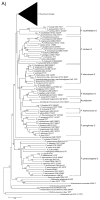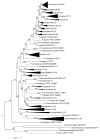Genomics in Bacterial Taxonomy: Impact on the Genus Pseudomonas
- PMID: 32013079
- PMCID: PMC7074058
- DOI: 10.3390/genes11020139
Genomics in Bacterial Taxonomy: Impact on the Genus Pseudomonas
Abstract
The introduction of genomics is profoundly changing current bacterial taxonomy. Phylogenomics provides accurate methods for delineating species and allows us to infer the phylogeny of higher taxonomic ranks as well as those at the subspecies level. We present as a model the currently accepted taxonomy of the genus Pseudomonas and how it can be modified when new taxonomic methodologies are applied. A phylogeny of the species in the genus deduced from analyses of gene sequences or by whole genome comparison with different algorithms allows three main conclusions: (i) several named species are synonymous and have to be reorganized in a single genomic species; (ii) many strains assigned to known species have to be proposed as new genomic species within the genus; and (iii) the main phylogenetic groups defined by 4-, 100- and 120-gene multilocus sequence analyses are concordant with the groupings in the whole genome analyses. Moreover, the boundaries of the genus Pseudomonas are also discussed based on phylogenomic analyses in relation to other genera in the family Pseudomonadaceae. The new technologies will result in a substantial increase in the number of species and probably split the current genus into several genera or subgenera, although these classifications have to be supported by a polyphasic taxonomic approach.
Keywords: Pseudomonas; genomics; phylogenomics; taxonomy.
Conflict of interest statement
The authors declare no conflict of interest.
Figures





References
-
- Mulet M., Lalucat J., García-Valdés E. DNA sequence-based analysis of the Pseudomonas species. Environ. Microbiol. 2010;12:1513–1530. - PubMed
Publication types
MeSH terms
Substances
LinkOut - more resources
Full Text Sources

